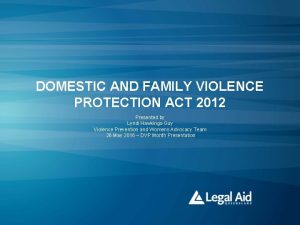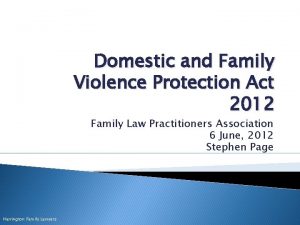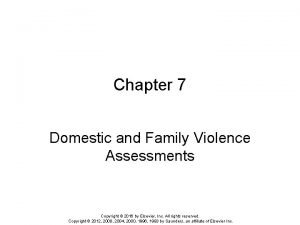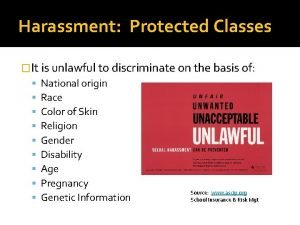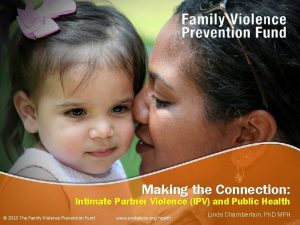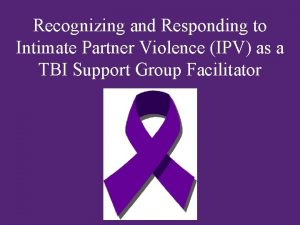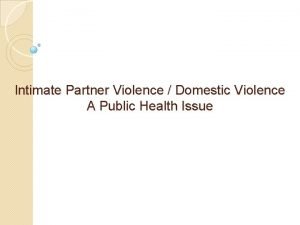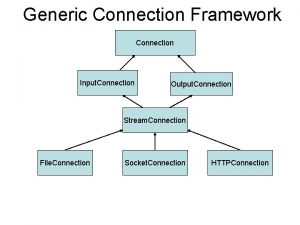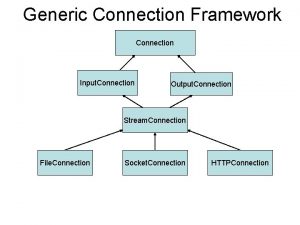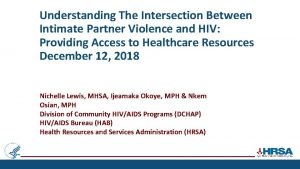Making the Connection Intimate Partner Violence IPV and







































- Slides: 39

Making the Connection: Intimate Partner Violence (IPV) and Public Health © 2010 The Family Violence Prevention Fund www. endabuse. org/health Linda Chamberlain, Ph. D MPH

For more information and program support, contact the National Health Resource Center on Domestic Violence, a project of the Family Violence Prevention Fund: • Monday-Friday (9 -5 PST) • Toll-free (888) Rx-ABUSE (792 -2873) • TTY: (800) 595 -4889 • Online: www. endabuse. org/health In addition, this Power. Point presentation may be downloaded from the Family Violence Prevention Fund's website: www. endabuse. org/health

The National Health Resource Center on Domestic Violence provides specialized materials and tools including: • Consensus Guidelines on Routine Assessment for D. V. • Pediatric Guidelines on Routine Assessment for D. V. • Business Case for Domestic Violence • Multilingual Public Education Materials • Training Videos • Multi-disciplinary policies and procedures • Cultural competency information and materials specific to many communities • Online e-Journal: Family Violence Prevention and Health Practice • Health Cares About Domestic Violence Day (2 nd Wednesday of October annually) Visit www. endabuse. org/health for more information

MENU SELECT FROM THE TOPICS BELOW IPV and Sexually Transmitted Infections/HIV Overview IPV and Perinatal Programs Regional and Local Data IPV, Breastfeeding, and Nutritional Supplement Programs Medical Cost Burden and Health Care Utilization for IPV and Child and Adolescent Health The Impact of IPV on Women’s Health ACE Study: Leading Determinants of Health IPV and Behavioral Health IPV and Injury Prevention IPV and Family Planning, Birth Control Sabotage Pregnancy Pressure, and Unintended Pregnancy IPV and Home Visitation Linda Chamberlain, Ph. D MPH

Overview: Intimate Partner Violence (IPV) as a Public Health Priority

‘ 85 6 ‘ 87 ‘ 88 ‘ 89 ‘ 90 ‘ 91 • 1985 – Surgeon General declares DV a leading public health issue • 1989 – ACOG Technical Bulletin • 1991 – ANA Position Statement • 1992 – AMA Diagnostic Guidelines • 1992 – APHA Position Paper ‘ 92

‘ 94 ‘ 95 ‘ 96 ‘ 97 ‘ 98 ‘ 99 • 1994 – AAFP Position Paper • 1998 – AAP Policy Statement • 1999 – APA Resolution ‘ 00 ‘ 01 ‘ 02 2000 – AANP Statement and Resolutions • 2002 – WHO declares violence a worldwide public health issue • 7

8 • Many different definitions • Most definitions include physical abuse, psychological/emotional abuse, and sexual assault • Prevalence rates vary significantly between current, recent, and lifetime abuse • Earlier studies were often limited to physical abuse

Intimate partner violence is a pattern of assaultive and coercive behaviors including: Inflicted physical injury • Psychological abuse • Sexual assault • Progressive social isolation • Family Violence Prevention Fund, 2002 9 Stalking • Deprivation • Intimidation and threats •

IPV was a precipitating factor in of female homicides { IPV was a precipitating factor in nearly one-third of suicides } CDC, 2009 10

Approximately of all murder-suicides involved an intimate partner Violence Policy Center, 2006 11

Lifetime prevalence of physical and/or sexual IPV among women from 10 different countries ranged from 15% to 71% World Health Organization, 2005 12

Lifetime prevalence of having been raped and/or physically assaulted by a current or former partner: 24. 8% of women 7. 6% of men Tjaden & Thoennes, 2000 13

60, 799 victims served National Network to End Domestic Violence, 2008 14

84% of spouse abuse victims are female Bureau of Justice Statistics, 2005 15

African American, Native American, and Hispanic women are at significantly greater risk for IPV Silverman et al, 2006; Field & Caetano, 2005 16

Prevalence rates of IPV in the past year among women seen at a community health care system: – 18. 5% disclosed physical violence – 14. 4% disclosed sexual coercion – 72. 6% disclosed psychological aggression Hazen & Soriano, 2007 17

Couples with IPV are more likely to be economically vulnerable and live in disadvantaged neighborhoods Fox & Benson, 2006 18

60% of homeless young adults disclosed abuse by a current partner Boris et al, 2002 19

• Prevalence among same-sex couples varies by gender of the couple and by the perpetrator’s gender • Persons with disabilities are at high risk for IPV Hathaway et al, 2000; Mc. Farlane et al, 2001; Tjaden & Thoennes, 2000 20

adolescents experience serious physical and/or sexual dating violence Wolitzky-Taylor et al, 2008 21

to high school-aged teens are hit, slapped, or beaten by a dating partner each year Wolfe et al, 2009 22

Teens experiencing physical dating violence are more likely to engage in: – Sexual intercourse – Suicide attempts – Episodic heavy drinking – Physical fighting MMWR, 2006 23

have been exposed to physical IPV in the past year Mc. Donald et al, 2006 24

IPV is associated with Leading Health Indicators for Healthy People 2010 25

26 INDICATOR CONNECTION WITH IPV Tobacco Use Increased risk of smoking Substance Abuse Increased risk of high risk alcohol use Injury & Violence Leading cause of injuries and homicide Mental Health Increased risk of mental health problems (Hathaway et al, 2000) (Lemon et al, 2002) (Frye et al, 2001) (Coker et al, 2002)

INDICATOR CONNECTION WITH IPV Responsible Sexual Behavior Increased sexual risk-taking and STIs (Coker, Sexual Behavior, 2000); Less likely to use condoms consistently (Wingood et al, 2001) Access to Health Care Increased risk of late entry into prenatal care Immunizations (Mc. Farlane et al, 1992; Silverman et al, 2006) Children of battered women less likely to get immunizations (Attala et al, 1997; Bair-Merritt et al, 2008; Webb et al, 2001) Body Weight 27 Overweight & Current body mass >25 (Black & Breiding, Obesity, 2008); weight gain (Sato-Di. Lorenzo & Sharps, 2007)

IPV costs the USA economy $12. 6 Billion on an annual basis Waters et al, 2004 28

• To integrate culturally relevant prevention, screening, intervention, and referral strategies for IPV into the public health setting 29

• 30 Develop partnerships with local domestic violence programs • Join or create multidisciplinary task forces to promote a coordinated community response to IPV • Conduct community needs assessments

• Establish policies to institutionalize routine screening in public health settings • Develop, implement, and monitor protocols for IPV in public health agencies • 31 Integrate IPV curricula into schools of public health, nursing, and medicine

• Enhance data collection and dissemination • Promote social marketing campaigns and community education • Increase funding for science-based, public health approaches • Provide technical assistance and evaluation • Advocate for local, state, and national policy reform 32

• Ongoing training for public health professionals • Implement policies to improve the safety of victims and employees in the workplace • Ensure that employee assistance programs have protocols 33

Public Health brings special skills and a unique perspective to address IPV: 34 • Prevention focus • Working collaboratively across disciplines • Scientific, data-based approach • Long tradition of promoting social change and prevention

Listening and affirmation are invaluable to victims. 35

Primary Prevention: PRIMARY PREVENTION For clients who are not experiencing abuse, screening affirms that IPV is an important health care issue and provides an opportunity to talk about healthy relationships and the warning signs of an abusive relationship. 36

Secondary Prevention: PRIMARY PREVENTION SECONDARY PREVENTION 37 In the early stages of an abusive relationship, early identification and intervention can prevent serious injuries and chronic illnesses as the violence escalates and the entrapment increases.

Tertiary Prevention: PRIMARY PREVENTION In relationships with escalating violence, screening provides the opportunity for SECONDARY PREVENTION TERTIARY PREVENTION disclosure in a safe and confidential environment. Even if clients do not feel safe disclosing their abuse, giving supportive messages can end their isolation and let them know that they have options. 38

• State and local health departments partnered with domestic violence agencies to create screening guidelines • Regional train-the-trainers sessions with teams of domestic violence advocates and health department staff • 39 Training teams train staff in their counties
 The spyware used in intimate partner violence
The spyware used in intimate partner violence Connections in literature
Connections in literature Bolted connection
Bolted connection A 325
A 325 Minimum fillet weld size
Minimum fillet weld size Family of orientation
Family of orientation Intimate family chapter 7
Intimate family chapter 7 Define the relationship chap 7
Define the relationship chap 7 Intimate distance is:
Intimate distance is: Intimate family chapter 6
Intimate family chapter 6 Intimate family chapter 6
Intimate family chapter 6 Intimate family chapter 2
Intimate family chapter 2 Intimate family chapter 2
Intimate family chapter 2 Example consultative register
Example consultative register Dewgarden foaming intimate wash benefits
Dewgarden foaming intimate wash benefits Zones of space communication
Zones of space communication Intimate zone in communication
Intimate zone in communication Cankaya university
Cankaya university 01 me line intimate
01 me line intimate Abcde of intimate relationship
Abcde of intimate relationship The impact of incarceration on intimate relationships
The impact of incarceration on intimate relationships War making and state making as organized crime
War making and state making as organized crime What is inference
What is inference Modifiers of human act.
Modifiers of human act. Domestic and family violence protection act 2012
Domestic and family violence protection act 2012 Gandhi king and mandela what made non-violence work dbq
Gandhi king and mandela what made non-violence work dbq Chapter 9 resolving conflicts and preventing violence
Chapter 9 resolving conflicts and preventing violence Chapter 27 anger aggression and violence
Chapter 27 anger aggression and violence Chapter 10 section 2 protest resistance and violence
Chapter 10 section 2 protest resistance and violence S68r family law act
S68r family law act Chapter 9 resolving conflicts and preventing violence
Chapter 9 resolving conflicts and preventing violence Ebb tide tackle
Ebb tide tackle Framework agreement on harassment and violence at work
Framework agreement on harassment and violence at work Routine, universal screening for domestic violence means: *
Routine, universal screening for domestic violence means: * Workplace violence and harassment quiz answers
Workplace violence and harassment quiz answers Seceding states of the confederacy
Seceding states of the confederacy Academy on violence and abuse
Academy on violence and abuse Ken renard
Ken renard Ipv 4
Ipv 4 Ipv format
Ipv format
























